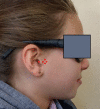Evaluation of the Functional Treatment of Patients With Skeletal Class II Malocclusion Using Low-Level Laser Therapy-Assisted Twin-Block Appliance: A Three-Arm Randomized Controlled Trial
- PMID: 35345811
- PMCID: PMC8956494
- DOI: 10.7759/cureus.23449
Evaluation of the Functional Treatment of Patients With Skeletal Class II Malocclusion Using Low-Level Laser Therapy-Assisted Twin-Block Appliance: A Three-Arm Randomized Controlled Trial
Abstract
Background Different techniques have been used to reduce functional treatment time including low-level laser therapy (LLLT), and the majority of studies have been conducted on animals. Therefore, the aim of the current study was to evaluate the effects of LLLT on improving orthodontic functional treatment using the Twin-Block (TB) appliance. Materials and methods This study was a three-arm, parallel-group randomized controlled trial. Patients were selected using the following inclusion criteria: skeletal Class II Division 1 malocclusion resulting from mandibular retrognathia (angle between the anterior cranial base and the NB plane (i.e., SNB angle): 73°-78°), the sagittal skeletal discrepancy angle (ANB angle) between 4° and 9°, and overjet between 5 and 9 mm. Forty-eight patients were randomly allocated into three equal groups. In the LLLT-TB group, the low-level laser device was used with a wavelength of 808 nm and power of 250 mW in addition to functional treatment with a Twin-Block appliance. The laser was applied on the skin at the bilateral temporomandibular joint (TMJ) regions, at five points, each point received 5 J of the laser for 20 seconds. The laser course was twice a week in the first month, every two weeks in the second month, and every three weeks up to the end of the treatment. The second group (the TB group) received functional treatment with a Twin-Block appliance, while patients in the third group (the untreated control group (UCG)) were observed for nine months without any intervention. Results There were statistically significant differences in treatment periods between the LLLT-TB group and the TB group (129 days and 235 days, respectively, P-value<0.001). The change in the effective mandibular length (Co-Gn) was the highest in the LLLT-TB group compared with the TB and the UCG groups (4.41 mm, 3.66 mm, and 1.07 mm, respectively; P-value<0.001). Conclusions The application of low-level laser therapy on the condylar regions accelerated the functional treatment in skeletal Class II malocclusion patients by approximately 45% and increased the bone growth and mandibular length. The improvement in the SNB angle was similar in both interventional groups. Irradiation of low-level laser stimulated bone growth at the condyles and did not cause anterior movement of the temporomandibular joint following functional orthopedic correction.
Keywords: acceleration of bone formation; class ii malocclusion; duration of treatment; functional treatment; low-level laser therapy; mandibular length; mandibular retrognathism; temporomandibular joint; tmj morphology; twin block.
Copyright © 2022, Abdulhadi et al.
Conflict of interest statement
The authors have declared that no competing interests exist.
Figures




Similar articles
-
Cephalometric changes in pharyngeal airway dimensions after functional treatment with twin block versus myobrace appliances in developing skeletal class II patients: a randomized clinical trial.BMC Oral Health. 2023 Dec 13;23(1):998. doi: 10.1186/s12903-023-03701-9. BMC Oral Health. 2023. PMID: 38093237 Free PMC article. Clinical Trial.
-
Comparative Evaluation of Twin Block Appliance and Fixed Orthodontic Appliance in Early Class II Malocclusion Treatment: A Randomized Controlled Trial.J Contemp Dent Pract. 2022 Nov 1;23(11):1111-1121. doi: 10.5005/jp-journals-10024-3426. J Contemp Dent Pract. 2022. PMID: 37073934 Clinical Trial.
-
Three-Dimensional Assessment of Mandibular Condylar Volume and Position Subsequent to Twin Block Functional Therapy of Skeletal Class II Malocclusion Accompanied by Low-Level Laser Therapy.Dent J (Basel). 2020 Oct 9;8(4):115. doi: 10.3390/dj8040115. Dent J (Basel). 2020. PMID: 33050123 Free PMC article.
-
Effects of orthodontic treatment with activator appliance on patients with skeletal Class II malocclusion: a systematic review and meta-analysis.Ann Palliat Med. 2021 Dec;10(12):12319-12334. doi: 10.21037/apm-21-3205. Ann Palliat Med. 2021. PMID: 35016488
-
Meta-analysis of condylar changes produced by a Twin-block appliance in Class Ⅱ malocclusion.Hua Xi Kou Qiang Yi Xue Za Zhi. 2023 Aug 1;41(4):463-470. doi: 10.7518/hxkq.2023.2023052. Hua Xi Kou Qiang Yi Xue Za Zhi. 2023. PMID: 37474479 Free PMC article. Chinese, English.
Cited by
-
Three-Dimensional Assessment of the Temporomandibular Joint Changes Following Reversed Twin Block Therapy of Patients With Skeletal Class III Malocclusion in Conjunction With the Photobiomodulation Therapy: A Randomized Controlled Clinical Trial.Cureus. 2022 Jun 13;14(6):e25897. doi: 10.7759/cureus.25897. eCollection 2022 Jun. Cureus. 2022. PMID: 35720777 Free PMC article.
-
Evaluation of Local Application of Glucosamine Sulfate and Chondroitin Sulfate on Temporomandibular Joint Response and Alleviation of Pain and Tension During the Functional Treatment of Skeletal Class II Patients: A Randomized Control Clinical Trial.Cureus. 2023 Feb 3;15(2):e34608. doi: 10.7759/cureus.34608. eCollection 2023 Feb. Cureus. 2023. PMID: 36751570 Free PMC article.
References
-
- Bishara SE. Textbook of orthodontics. Philadelphia, Pa.: Saunders; 2001. xv, 592 p. p. Philadelphia, PA: WB Saunders Company; 2001. Textbook of Orthodontics.
-
- Mandibular changes produced by functional appliances in Class II malocclusion: a systematic review. Cozza P, Baccetti T, Franchi L, De Toffol L, McNamara JA Jr. Am J Orthod Dentofacial Orthop. 2006;129:599–512. - PubMed
-
- Biostimulation of mandibular condyle growth. Oksayan R, Ciftci ME, Aktan AM, Sokucu O. http://go.gale.com/ps/i.do?id=GALE%7CA428957836&sid=googleScholar&v=2.1&... J Orthod Res. 2015;3:147.
-
- A clinical investigation of the efficacy of low level laser therapy in reducing orthodontic postadjustment pain. Lim HM, Lew KK, Tay DK. Am J Orthod Dentofacial Orthop. 1995;108:614–622. - PubMed
-
- Effect of low level laser therapy on the repair of bone defects grafted with inorganic bovine bone. Pinheiro AL, de Assis Limeira F Junior, Gerbi ME, Ramalho LM, Marzola C, Ponzi EA. http://www.scielo.br/j/bdj/a/3SqYVFfn7KwBkd8P9Y4SDSx/?format=pdf&lang=en. Braz Dent J. 2003;14:177–181. - PubMed
LinkOut - more resources
Full Text Sources
Medical
